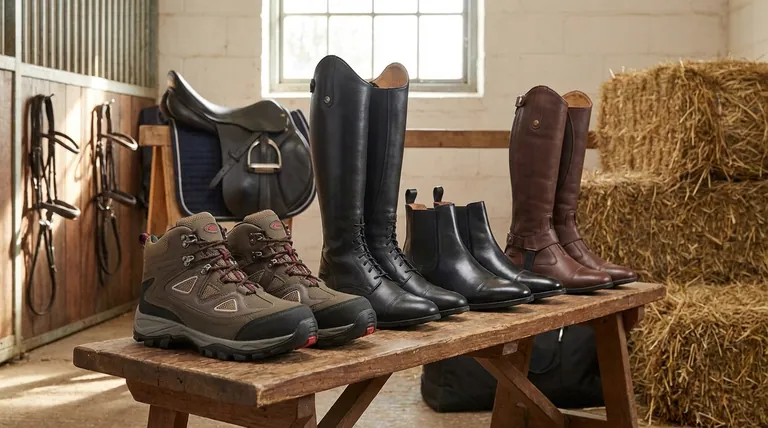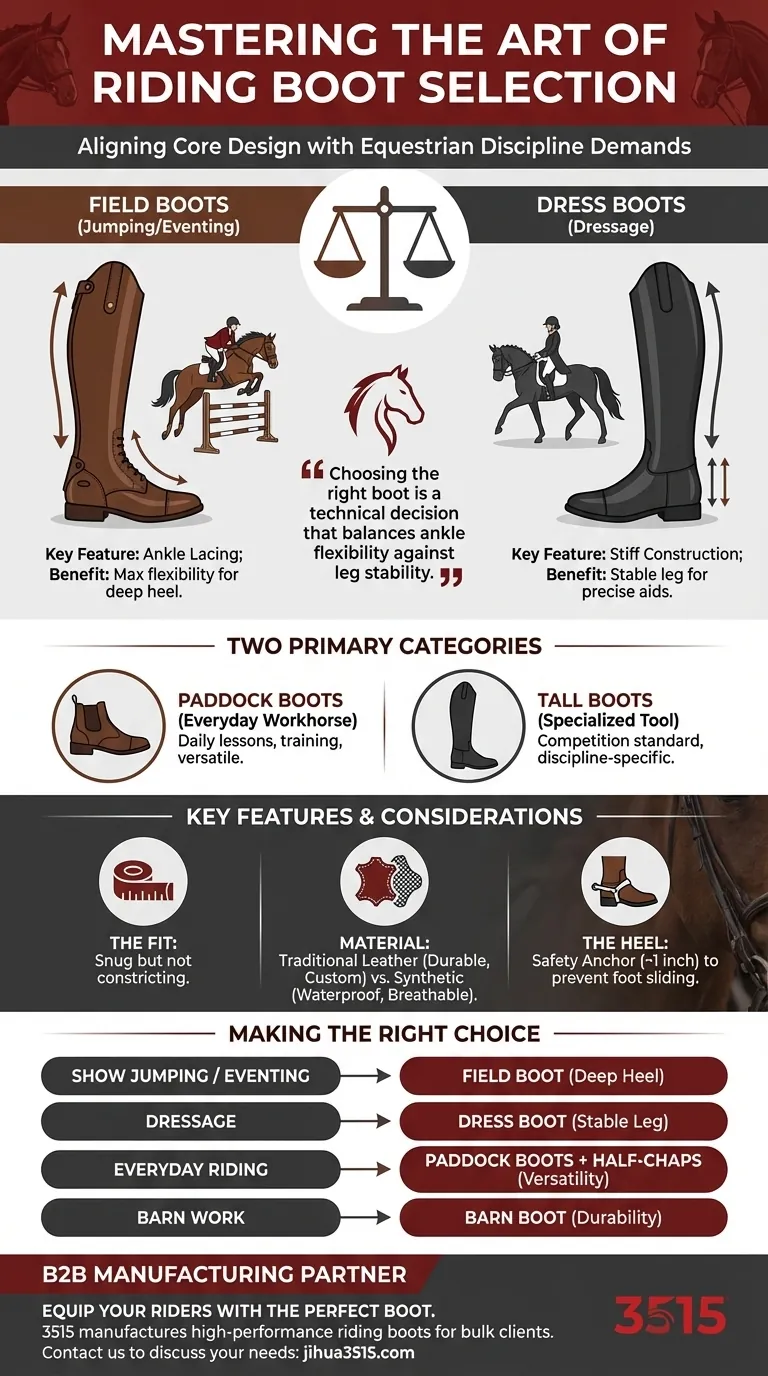The most critical consideration when choosing riding boots is aligning the boot's core design—specifically its ankle flexibility and overall stiffness—with the unique physical demands of your equestrian discipline. For example, show jumping requires significant ankle flexion for a deep heel position over fences, whereas dressage demands a stiff, stable leg for subtle communication.
Choosing the right riding boot is a technical decision that balances ankle flexibility against leg stability. Understanding this core trade-off is the key to selecting footwear that enhances your performance, safety, and communication with your horse.

The Two Primary Categories of Riding Boots
To make an informed choice, you must first understand the fundamental differences between the main types of boots available. Each serves a distinct purpose in a rider's wardrobe.
Paddock Boots (The Everyday Workhorse)
Paddock boots, also known as jodhpur boots, are ankle-height. They are the go-to choice for daily lessons, training, and general riding.
For more formal schooling or showing, they are typically paired with half-chaps to create the look and function of a tall boot.
Tall Boots (The Specialized Tool)
Tall boots extend up the leg to just below the knee, providing a clean leg line and closer contact with the horse. They are the standard for competition and are highly specialized for different disciplines.
The two main sub-categories of tall boots are Field Boots and Dress Boots.
Discipline-Specific Boots: Form Follows Function
The subtle design differences in tall boots are not for style; they are engineered to meet the specific requirements of a rider's position and aids in a given discipline.
Field Boots for Jumping and Eventing
The defining feature of a Field Boot is the lacing at the ankle. This design provides the necessary flexibility for a rider's heel to drop down when shortening their stirrups for jumping.
This range of motion is essential for maintaining balance and a secure lower leg position over fences. These boots are the standard for show jumping, eventing, and hunt seat equitation.
Dress Boots for Precision and Stability
Dress Boots are characterized by their stiffness and lack of laces. They are traditionally worn by dressage riders, who use a much longer leg and stirrup length.
The rigid construction helps to immobilize the ankle, creating a very still and stable leg. This allows the rider to give precise, subtle aids to the horse with minimal movement.
Understanding the Trade-offs and Key Features
Beyond the primary type, several key features determine a boot's performance, comfort, and longevity.
The Fit: Snug but Not Constricting
Your boots should fit snugly through the calf and ankle without cutting off circulation. A proper fit ensures your leg remains secure and allows for clear communication through the boot to the horse.
Material Matters: Leather vs. Synthetic
Traditional leather (such as full-grain or calfskin) is prized for its durability, custom fit over time, and classic appearance.
Modern synthetic materials offer advantages like waterproofing, increased breathability, and often a lower price point with minimal break-in time.
The Heel: Your Safety Anchor
The heel of any riding boot is a critical safety feature. It must be substantial enough—typically around one inch—to prevent your foot from sliding completely through the stirrup iron.
However, it should not be so tall that it becomes uncomfortable or alters your natural foot position.
Making the Right Choice for Your Goal
Select your boot based on its intended function to ensure optimal performance and safety.
- If your primary focus is Show Jumping or Eventing: Prioritize a Field Boot with ankle laces to ensure maximum flexibility for a deep heel position.
- If your primary focus is Dressage: Select a stiff, reinforced Dress Boot to maintain the quiet, stable leg position required for precise aids.
- If your primary focus is everyday riding and lessons: A quality pair of Paddock Boots, combined with half-chaps, offers the best versatility and value.
- If your primary focus is barn work and casual riding: A durable and often waterproof Barn Boot is the most practical choice for groundwork and light riding.
Ultimately, the right boot acts as an extension of your leg, providing the precise support and freedom your discipline demands.
Summary Table:
| Discipline | Recommended Boot Type | Key Feature | Primary Benefit |
|---|---|---|---|
| Show Jumping / Eventing | Field Boot | Ankle Lacing | Maximum flexibility for a deep heel position |
| Dressage | Dress Boot | Stiff, Reinforced Construction | Stable leg for precise, subtle aids |
| Everyday Riding / Lessons | Paddock Boots with Half-Chaps | Ankle-Height | Versatility and value for training |
| Barn Work / Casual Riding | Barn Boot | Durable, Often Waterproof | Practicality for groundwork and light riding |
Ready to Equip Your Riders with the Perfect Boot?
As a leading manufacturer, 3515 produces a comprehensive range of high-performance riding boots tailored for distributors, brand owners, and bulk clients. Whether you need flexible field boots for jumpers or rigid dress boots for the dressage arena, our production capabilities ensure quality, durability, and discipline-specific design.
Let us help you supply the footwear that enhances performance, safety, and communication between rider and horse.
Contact our team today to discuss your manufacturing needs and see how we can support your business.
Visual Guide

Related Products
- Safety Footwear Wholesale Manufacturer for Custom OEM/ODM Production
- Factory-Direct Wholesale Canvas Boots with High-Traction Rubber Soles
- Wholesale High-Traction Camo Boots - Custom Manufacturer for Brands
- Customizable Anti-Smash Safety Boots for Wholesale & Private Label Manufacturing
- Premium Wholesale Waterproof Safety Boots High Performance Protection for Industrial Markets
People Also Ask
- What are the cultural perspectives on wearing shoes in the house? A Guide to Home Etiquette & Hygiene
- Do snake bite boots work? Your Ultimate Guide to Effective Snake Bite Protection
- What are the differences between steel toe, composite toe, and alloy toe Wellington boots? Choose the Right Safety Toe for Your Job
- Is it normal to wear shoes in the house? A Guide to Hygiene, Comfort & Culture
- How long can you wear safety boots? The Lifespan is Determined by Wear, Not Time



















